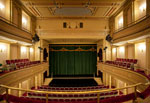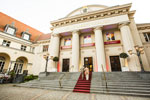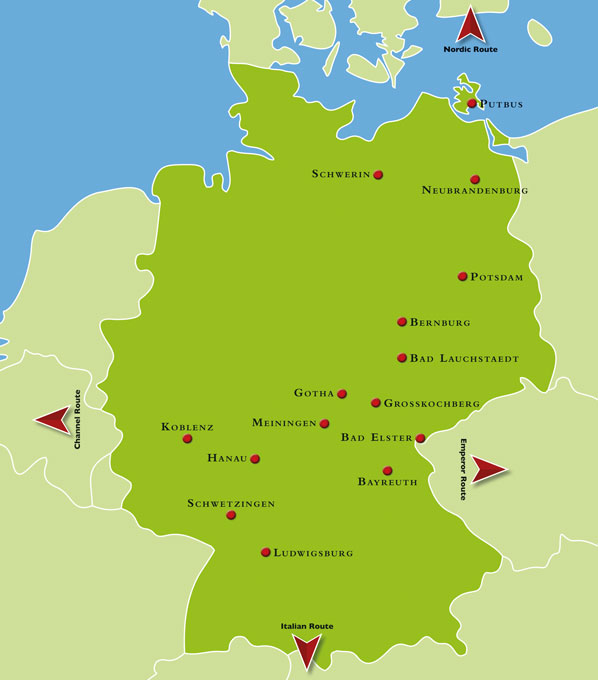 Putbus Theatre
Putbus Theatre
Visiting the theatre in Putbus is an integral part of every holiday on the island of Ruegen. It is situated in a town that Marques Wilhelm Malte of Putbus (1784–1854) commissioned as his seat–it is also the second oldest spa on the coast of the Baltic Sea after Heiligendamm. In a capital and in a spa there had to be a theatre. And thus it was inaugurated in 1821. Redesigned in 1826, it was sanitized and restored at great expense from 1992 to 1998. Since then this gem of North German Classicism has been glittering with its old beauty. In cooperation with the theatres in Stralsund and Greifswald (“Theatre Vorpommern”) about 300 performances per year are presented here.
Theater Putbus ⋅ Markt 13 · 18581 Putbus ·
Tel.: +49 (0)38381 808 30 · E-mail: service@theater-putbus.de · www.theater-putbus.de
Visits: on appointment
 Mecklenburg State Theatre
Mecklenburg State Theatre
The theatre in Schwerin was inaugurated 125 years ago. It is situated opposite the palace and next to the then also newly constructed Museum of Fine Arts. Behind its neo-Renaissance facade, architect Georg Daniel designed a neo-Baroque auditorium with three tiers seating 540 spectators, as well as noteworthy foyers. Today it has its own permanent ensembles and orchestra, presenting plays, operas and ballets as well as puppet theatre and plays in dialect. The theatre of the capital of the state of Mecklenburg-West Pomerania therefore not only boasts of a perfectly restored building, but also of excellent productions. There are also some specials to discover, like the painted front curtain from 1886 with an allegory by Ernst Hartmann, a Walcker organ and a stage organ from 1883, and 19th century machinery for theatrical effects.
Mecklenburgisches Staatstheater ⋅ Alter Garten 2 ⋅ 19055 Schwerin ⋅ Tel.: +49 (0)385 530 00 ⋅ E-mail: service@mecklenburgisches-staatstheater.de
⋅ www.mecklenburgisches-staatstheater.de
Visits: guided tours on changing days, please consult the website of the theatre
 Playhouse
Playhouse
When at the end of WW II the historic city centre of Neubrandenburg fell victim to the flames, a gem remained miraculously intact: the Playhouse (Schauspielhaus). The baroque halftimbered building made of clay bricks had been built in 1793/94 as a summer theatre for the court theatre troupe of Duke Adolf Friedrich IV of Mecklenburg-Strelitz. Today it is the oldest surviving theatre in the region. Used for non-theatrical purposes from the late 19th century onward, the building was rediscovered as a theatre by way of a thorough sanitation between 1990 and 1994. The unique barrel vaulting of the auditorium, the central box, the foyer and the outer walls were restored, the vanished stage replaced with a modern solution. Since then, the theatre and orchestra holding “Theater und Orchester GmbH Neubrandenburg/Neustrelitz” has been presenting 150 performances here every year, covering all genres.
Schauspielhaus ⋅ Pfaffenstrasse 18–22 ⋅ 17033 Neubrandenburg ⋅ Tel.: +49 (0)395 569 98 32 ⋅ E-mail: serviceb@landestheater-mecklenburg.de ⋅ www.theater-und-orchester.de
Visits: on appointment ⋅ Box office: Tues–Fri 10:00–17:00
 Theatre in the New Palace
Theatre in the New Palace
The theatre is temporarily closed for restoration!
The New Palace in Sanssouci park was built 1763–1769 for the Prussian king Frederick II the Great. Besides apartments for guests and banqueting halls, the king had a theatre installed in the south wing. The facade does not indicate the existence of a theatre. Only the statues on the eaves with their masques and musical instruments could be a hint. The auditorium inside has the form of an amphitheatre and is decorated in Frederick’s variant of the Rococo style: gilded hermes and rocailles contrast with the red velvet of the benches, gilded palm trees and trophies with musical instruments frame the stage. The theatre seats 226 spectators and offers operas, plays, and ballet performances all year round.
Schlosstheater im Neuen Palais ⋅ 14469 Potsdam ⋅ Tel.: +49 (0)331 9694 271 ⋅ E-mail: u.jagsch@spsg.de ⋅ www.spsg.de
Visits: temporarily closed for restoration!
 Goethe Theatre
Goethe Theatre
In 1802 the poet Johann Wolfgang von Goethe had this theatre built after his own design as a summer venue for his Weimar court theatre company in the spa town of Bad Lauchstaedt near Halle (Saale). The opening performance on June 26 the same year included a prologue written by the poet and his production of Mozart’s opera “Titus”. By way of a number of careful restoration campaigns this treasure of the German Classical period has been saved over centuries. Thus one can still immerse here in the theatre of Goethe’s time. During guided tours also the understage is shown with its reconstructed historical stage machinery that allows spectacular scene changes on the open stage. From May to October there are delightful performances of works by Goethe, Schiller, Mozart, Handel etc.
Goethe-Theater ⋅ Parkstrasse 18 ⋅ 06246 Bad Lauchstaedt ⋅ Tel.: +49 (0)34635 7820 ⋅ E-mail: info@goethe-theater.com ⋅ www.goethe-theater.com
Visits: Tues–Sun 10:30, 14:00, 16:00 (April–Oct); Mon–Fri 10:30 + 14:00 (Nov–March), weekends on appointment. Groups on appointment only! Limited visits on rehearsal or performance days
 Private Theatre at Kochberg Palace
Private Theatre at Kochberg Palace
The ensemble of palace, park and theatre Kochberg–once the country estate of Goethe’s love Charlotte von Stein–is one of the most pleasant places owned by the foundation Klassik Stiftung Weimar. A gem is the carefully restored neoclassical private theatre (“Liebhabertheater”) with its 75 seats, built for Carl von Stein in 1800. The stage area and the auditorium are festively adorned with columns and rare marbled paper. The dressing rooms and the tiny salons feature period furniture, so that the entire building breathes the air of 1800. On weekends between May and October, a programme featuring top-class opera and drama performances, chamber music and readings draws an audience from near and far to the little theatre in the countryside. The programme focuses on works from the Baroque, the Classical era and the Romantic period, which are performed mainly in period style in the authentic environment.
Liebhabertheater Schloss Kochberg ⋅
07407 Grosskochberg ⋅ Tel.: +49 (0)36743 225 32 ⋅
E-mail: vorstand@liebhabertheater.com ⋅ www.liebhabertheater.com
Klassik Stiftung Weimar ⋅ E-mail: info@klassik-stiftung.de ⋅ www.klassik-stiftung.de
Visits: access during the opening times of the palace, every day except Tuesday 10:00 to 18:00 (April–Oct) ⋅ Guided tours on appointment
 Ekhof Theatre
Ekhof Theatre
Friedenstein Palace, the largest early Baroque palace in Germany, not only houses outstanding art and antiques collections but also a focal point of German theatre history: the Ekhof Theatre. Built in 1681 and equipped with a still preserved stage machinery, it is presented today in its design from 1775 when modern German theatre started here. Until 1778 Conrad Ekhof, the “Father of German acting”, creator of the realistic style in theatre, served here as director of Germany’s first fully employed theatre troupe. Fixed days of performance, regular salaries, a growing repertoire, subscriptions, tickets sold to all citizens, subsidies, and a pension fund were unique assets of this Gotha court theatre. The theatre is preserved today exactly as it was in Ekhof’s time–including the stage machinery that springs to action during the Ekhof Festival (July, August).
Ekhof-Theater ⋅ Schloss Friedenstein ⋅ 99867 Gotha ⋅ Tel.: +49 (0)3621 823 451 ⋅ E-mail: service@stiftungfriedenstein.de ⋅ www.ekhof-festival.de
Visits Ekhof-Theater & Gotha theatre history exhibition: 10:00 to 17:00 (May–Oct); 10:00 to 16:00 (Nov–April)
 Meiningen Museums
Meiningen Museums
Theatre Museum
Starting in 1866, Duke Georg II of Saxe-Meiningen, the “theatre duke”, created a new style in theatre with his court theatre company, took it on tour, and caused a sensation all over Europe. “The Meiningers” became synonymous with up-to-date theatre. We can still get an impression of it by way of 280 original, hand-painted stage decorations, among them complete stage sets (above: “Cathy from Heilbronn”). They were painted in the workshop of the Brueckner brothers in Coburg who also worked for Richard Wagner. The collection is unrivalled in the world and is shown in presentations that change once every year. A film, a stage light show, original costumes, theatre posters and photographs round off the exhibition. In nearby Elisabethenburg Palace more theatre history is on display, e.g. the apartment of the theatre duke.
Meininger Museen ⋅ Schlossplatz 1 ⋅ 98617 Meiningen ⋅ www.meiningermuseen.de ⋅
Tel. palace: +49 (0)3603 50 36 41 ⋅
Tel. theatre museum: + 49 (0)3603 47 12 90
Visits Elisabethenburg palace: Tue–Sun 10:00 to 18:00
Presentation in the Theatre Museum in the riding hall: Tue–Sun 10, 12, 14, 16 hrs ⋅ Closed mid-January to mid-February
Meininger Theater ⋅ Bernhardstrasse 5 ⋅ www.das-meininger-theater.de ⋅ Guided tours: 8:45 to 10:00 and 14:00 to 16:00 ⋅ Tel. appointments: +49 (0)3603 45 11 36
 Margravial Opera House
Margravial Opera House
In June 2012, the Margravial Opera house was proclaimed a Unesco World Heritage: it is a unique monument of Europe's festival, theatre and music culture in the Baroque era. While the Opera House is undergoing extensive restorations, visitors will still be able to get a glimpse of the auditorium. A world heritage centre has opened in the foyers, where an exhibition presents a fascinating view of the building, its architect Giuseppe Galli Bibiena and the margravine Wilhelmine who commissioned the theatre. A 3D animation allows the visitor to experience the architecture in close-up and in an interactive way.
Also in and around Bayreuth: the theatre of ruins in the Hermitage (1744), the grotto theatre at Sanspareil (1747), Richard Wagner’s festival theatre (1876), and much more.
Markgräfliches Opernhaus ⋅ Opernstrasse 14 ⋅ 95444 Bayreuth ⋅ Tel.: +49 (0)921 7 59 69 22 ⋅ E-mail: sgvbayreuth@bsv.bayern.de ⋅ www.schloesser.bayern.de
Visits World Heritage Centre: 9:00 to 18:00 (April–Sep); 10:00 to 16:00 (Oct–March)
 Palace Theatre
Palace Theatre
The residential palace Ludwigsburg presents art and culture of the 18th and 19th century. Three new museums in the palace display paintings, china and royal fashion. A highlight is the palace theatre (Schlosstheater). It was constructed from 1758 onward by Philippe de la Guêpière for Duke Carl Eugen. King Friedrich I of Wurttemberg had the auditorium remodelled in Classicistic style by Friedrich von Thouret in 1812. The theatre was used until 1853, then deserted for 100 years. And so the auditorium, the stage and the complete stage machinery as well as painted front curtains and stage decorations of the 18th and early 19th century survived–the only ones in Germany and a rare collection in Europe. A permanent exhibition tells the story of the palace theatre. And music lovers meet for the Ludwigsburg palace festival from June to August (www.schlossfestspiele.de).
Schlosstheater ⋅ Schloss Ludwigsburg ⋅ Schlossstrasse 30 ⋅ 71634 Ludwigsburg ⋅ Tel.: +49 (0)7141 18 20 04 ⋅ E-mail: info@schloss-ludwigsburg.de ⋅ www.schloss-ludwigsburg.de
Visits as part of the palace tour: Mon–Sun 10:00 to 17:00 (summer), 10:00 to 16:00 (winter) ⋅ Special guided tours on appointment
Theatre museum open all year round Mon–Sun 10:00 to 17:00
 Rococo Theatre
Rococo Theatre
The Rococo Theatre (1752/ 53) by Nicolas de Pigage is the oldest still existing theatre in Europe with boxless circles. Just 20 years after its inauguration it was remodelled in the Classicistic style on the order of the art loving Elector Carl Theodor of the Palatinate. Today the simultaneity of the two styles gives the theatre its special appeal. The Rococo Theatre at Schwetzingen Palace was a venue for the Mannheimer Hofkapelle, for (first) performances of works by Voltaire, Mozart, Gluck and J. Chr. Bach. This tradition continues with the SWR Schwetzingen Festival (Schwetzinger Festspiele) in May and the Mozart Weeks (Mozartwochen) in September, when recitals and opera productions can be enjoyed in the Rococo Theatre. Also worthwhile seeing: the Baroque city centre of Schwetzingen and the famous palace gardens with its delightful buildings.
Rokokotheater ⋅ Schloss Schwetzingen ⋅ 68723 Schwetzingen ⋅ Tel.: +49 (0)6202 128 828 ⋅ E-mail: info@schloss-schwetzingen.de ⋅ www.schloss-schwetzingen.de
Visits: on appointment
 Playhouse Wilhelmsbad
Playhouse Wilhelmsbad
This theatre owns its existence to Prince Wilhelm of Hesse-Kassel, heir to the throne of Kurhesse. In January 1781 he ordered the treasury in Hanau to have 3500 florins ready “for the construction of a Comoedien Haus (playhouse) at Wilhelmsbad.” On July 8, 1781 the theatre–built to plans by the Councillor Franz Ludwig von Cancrin–was inaugurated with the operetta “Tom Jones” by François André Danican. Today there are still theatre performances and concerts in the Comoedienhaus, mostly organized by the Comoedienhaus Ltd., the City of Hanau cultural department, and the Volksbuehne Hanau e.V. In summer, the Comoedienhaus and the surrounding spa park are a unique location for the festivals “Hanauer Kultursommer” and “Wilhelmsbader Sommernacht.”
Comoedienhaus ⋅ Parkanlage 1 ⋅ 63454 Hanau-Wilhelmsbad ⋅ Tel.: +49 (0)6181 50 88 500 ⋅ E-mail: info@comoedienhaus.de
Visits: on appointment
 Municipal Theatre
Municipal Theatre
Archbishops, too, ordered theatres to be built. So in 1787, the archbishop of
Trier and Elector Clemens Wenzeslaus picked a private investor to erect a “House for Plays, Operas, Balls, and Assemblies” in the city of Koblenz. Only seven months later, on 23 November 1787, the theatre was inaugurated with Mozart’s “The Abduction from the Seraglio.” A week later the first play was performed: “The Brigands” by Schiller. In 1867 ownership was transferred to the city. The changes that had accumulated in the 200 years of its existence were reversed in 1984/85 and the theatre completely restored; the aim was to recover the original as accurately as possible. Today the Municipal Theatre houses three companies for drama, opera, and ballet and offers performances almost every day.
Theater Koblenz ⋅ Clemensstrasse 1 ⋅ 56068 Koblenz ⋅ Tel.: +49 (0)261 129 2840 & 2841 ⋅ E-mail: theaterkasse@stadt.koblenz.de ⋅ www.theater-koblenz.de
Visits: on appointment
 Carl Maria von Weber Theatre
Carl Maria von Weber Theatre
Duke Alexius Frederick Christian gave order in 1825 to erect in the immediate vicinity of the palace, and on 2 March 1827 the citizens of Bernburg enjoyed for the first time a performance in their very own theatre. In the years to come, great artists would perform here, like the violin virtuoso Niccolò Paganini in 1829 or Richard Wagner in 1834. In 1882 the theatre was remodelled by the Berlin architect Eduard Tietz, who also added the present facade, and more than a hundred years later, modern foyers were created. Thus two periods meet in this lovely theatre: 1882 and 1997. And much can be learned from it, also regarding the history of the whole Anhalt region. On stage, a mix of different professional companies and local amateur troupes offer interesting productions throughout the year.
Carl Maria von Weber Theater ▪ Bernburger Theater- und Veranstaltungs GmbH ▪ Schlossstr. 20 ▪ 06406 Bernburg ▪ Tel.: +49 (0)3471 34790 ▪ E-Mail: info@theater-bernburg.de ▪ www.theater-bernburg.de
Visits: on appointment
 King Albert Theatre
King Albert Theatre
Germany’s last court theatre is located in Saxony's most traditional state spa. The theatre is named after the simple predecessor building from 1888, when King Albert reigned in Saxony. Soon this theatre seemed too modest for the glamorous spa development. The new theatre was built and inaugurated in 1914 by the then King Friedrich August III. of Saxony. To meet the expectations of international and royal guests, the architects Alfred Zapp and Erich Basarke designed a modern building mixing Art Nouveau and Neoclassicsm. The theatre is connected to a historic guesthouse. This allowed both, using the dining room as theatre refreshment room and indoor access for hotel guests. Today, events all year round still guarantee royal entertainment.
König Albert Theater ▪ Theaterplatz 1 ▪ 08645 Bad Elster ▪ Tel.: +49 (0) 37437 53 900 ▪ E-mail: touristinfo@badelster.de ▪ www.koenig-albert-theater.de
Visits: on appointment
The German Route
Counts, dukes and kings were the driving force of theatre life in Germany from the 17th to the 19th century. Let’s make a journey to their theatres and find out what they have to tell us. (Please move the cursor across a city name to get information on the theatre.)

Our journey starts on the island of Ruegen. In this ideal holiday place the Marques Malte of Putbus built his ideal city–complete with a theatre (1821), of course. On the mainland, Duke Adolf Friedrich IV did not want to be without a theatre even in his summer resort Neubrandenburg, and so he had a summer theatre erected in 1797, a half-timbered building. The shining example was the Prussian king Frederick the Great who built four theatres. Of those four his private theatre (1769) in the New Palace in Potsdam-Sanssouci can still be visited.
Travelling south we enter Goethe’s world. Near the city of Halle (Saale) where Handel was born we find the historic spa Bad Lauchstaedt and the Goethe Theatre which the famous poet had built in 1802. After a little excursion to Weimar we arrive at the private theatre (1800) of the Stein family at Kochberg palace. And finally there is the palace theatre in Gotha, the Ekhof Theatre (1681/1775).
 From Gotha, the centre of German theatre in the 18th century, to the centre of German theatre in the 19th century: Meiningen. Duke Georg II, the theatre duke, created a theatrical style that was copied throughout Europe. The style is embodied in the huge stage decorations that are still preserved and on display today.
From Gotha, the centre of German theatre in the 18th century, to the centre of German theatre in the 19th century: Meiningen. Duke Georg II, the theatre duke, created a theatrical style that was copied throughout Europe. The style is embodied in the huge stage decorations that are still preserved and on display today.
Not far away, in Bayreuth, we find one of Frederick the Great’s sisters, the Margravine Wilhelmine. She wanted to boost the image of her seat and built the most breath-taking theatre north of the Alps, the Margravial Opera House. It was inaugurated in 1748 on the occasion of the marriage of her daughter with the Duke of Wurttemberg. No sooner had the young couple arrived at their summer palace Ludwigsburg that they had a theatre built there, too (1758). Their neighbour, the Elector Carl Theodor of the Palatinate, was quicker: the Rococo Theatre in his summer palace Schwetzingen had been ready since 1752.
Prince Wilhelm of Hesse-Kassel thought more in commercial terms: in 1781 he ordered the construction of a “Comoedien Haus” near Hanau in order to lure guests into his new spa Wilhelmsbad. The archbishop Clemens Wenzeslaus had a similar idea, but lacking the financial means he left it to a Mr Schmitz to build and run the theatre (1787) in Koblenz. Thus our journey to historic theatres ends–or begins–with one of the oldest municipal theatres in Germany.
With the support of the Culture Programme of the European Union

 Deutsch
Deutsch English
English Français
Français
